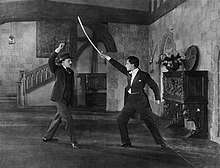The Blackguard
The Blackguard (German: Die Prinzessin und der Geiger) (1925) is a British-German drama film directed by Graham Cutts and starring Jane Novak, Walter Rilla, and Frank Stanmore.[1]
| The Blackguard | |
|---|---|
 | |
| Directed by | Graham Cutts |
| Produced by | |
| Written by | |
| Based on | The Blackguard by Raymond Paton |
| Starring | |
| Cinematography | Theodor Sparkuhl |
Production company | |
| Distributed by |
|
Release date |
|
| Country |
|
| Language |
|
Premise
Against the backdrop of the Russian Revolution, a violinist (Rilla) saves a princess (Novak) from execution.
Cast
- Jane Novak as Prinzessin Maria Idourska / Princess Marie Idourska
- Walter Rilla as Michael Caviol, The Blackguard
- Frank Stanmore as Pompouard
- Bernhard Goetzke as Adrian Levinsky
- Rosa Valetti as Grandmother
- Dora Bergner as Duchess
- Fritz Alberti as Painter
- Robert Leffler as Leidner
- Alexander Murski as Vollmark
- Martin Herzberg as Michael Caviol as a boy
- Loni Nest as Prinzessin Maria as little girl
- Robert Scholz as Grandduke Paul
Production
The film was a co-production between Gainsborough Studios and UFA initiating a decade-long series of co-productions which ended with the rise of the Nazi Party in the 1930s.[2] The film was based on the novel The Blackguard by Raymond Paton, and shot at Studio Babelsberg, in Potsdam near Berlin, the first time a Gainsborough film was shot abroad. The film was one of a number of films made in this genre during the 1920s, the most successful of which was the American film The Student Prince in Old Heidelberg (1927).[3]
While working on the film, Alfred Hitchcock was able to study several films being made nearby, including The Last Laugh (1924) by F. W. Murnau, which were a major influence on his later work.
References
- The Blackguard (1925)
- Cook p. 16–17
- Cook p. 36
Bibliography
- Cook, Pam, ed. (1997). Gainsborough Pictures. London: Cassell. ISBN 978-0-304-33708-8.
- Kreimeier, Klaus (1999). The Ufa Story: A History of Germany's Greatest Film Company, 1918–1945. Berkeley: University of California Press. ISBN 978-0-520-22069-0.